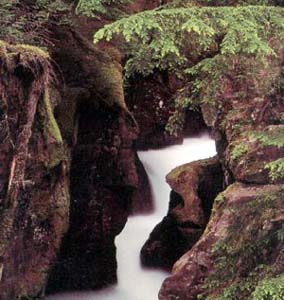Core Principle 1: Watersheds are natural systems that we can work with
Natural Processes at Work in the Watershed
Importantly, no matter where we live or work, we are in a watershed teeming with unique, inter-related natural processes. These natural forces help shape the watershed landscape, its water quality, and—in turn—our lives.
In mountain upland areas, there are unique blends of climate, geology, hydrology, soils, and vegetation shaping the landscape, with waterways often cutting down steep slopes. Look closely at this picture and the many things that influence water quality: chemicals from the mineral weathering of rocks, from the decay of vegetation, and from groundwater. Notice how the vegetation shades the water, influencing temperature and what can live in the water.
In an upland plains area, you find grassy plains, hardy vegetation, and slower moving, meandering streams and rivers.
In the coastal area, where oceans meet land, there are again different blends of features and processes shaping the environment.
In lowland areas between upland and coastal waters, where tidal wetlands are prevalent, processes serve entirely different functions.
In other words, each watershed—indeed each watershed zone—has unique living and nonliving components that interact, with one element responding to the action or change of another. Knowing your watershed means coming to learn the natural processes working within the watershed boundaries.
![[logo] US EPA](https://www.epa.gov/epafiles/images/logo_epaseal.gif)
